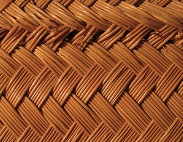
The Art of Esparto Weaving
Some say that the art of weaving esparto grasses is dying out, as younger generations of Spanish have been drawn away from spending their free time making traditional handicrafts by new technology and the modern world. However, look a little closer and you’ll discover that esparto is still widely used, and was even adopted by fashion houses as one of the major spring trends of 2011.
Esparto is the Spanish name for needle-grass of the variety Stipa tenacissima. Native to the Iberian Peninsula and North Africa, esparto is a hardy perennial which flourishes in dry, sandy terrain. The fibrous nature of the tall, drought resistant plant makes it ideal for weaving and binding, which is exactly what the resourceful people of Spain have been doing for centuries.
Esparto has long been used to make ropes and cords, baskets and mats, paper, and of course, the classic espadrille shoe – which have seen a recent resurge in popularity after being showcased on catwalks by brands such as Prada. As an environmentally friendly, sustainable material, esparto has huge potential, and not just for weaving. In some coastal areas of Spain, esparto has been planted on sand dunes, as the sturdy root structures help to stabilise the natural structures.
While once esparto weaving would have been a profession, the reduced demand for artisan-made objects has meant that those who work with the grass today, do so as a hobby rather than a trade. At one time, esparto weaving was a dominant industry in some regions of the country – particularly Murcia, Valencia and Andulucia.
Visitors to Spain will find that much is being done to preserve the art of esparto crafts for the future, even though it may not be passed down from older family members to younger as in the past. Workshops and courses are available in many villages and towns, giving those who are interested the chance to learn this rewarding yet time-consuming craft. There are also museums dedicated to esparto, in particular the Pequeno Museo de Esparto in Cieza, Murcia.
If you are looking for a great souvenir to take home – something which is useful and typically Spanish, you can’t go wrong with esparto. Buying locally produced handicrafts is an excellent way to support the people who still produce them, and helps to ensure that this delicate art continues.
 Follow
Follow


